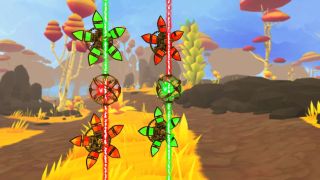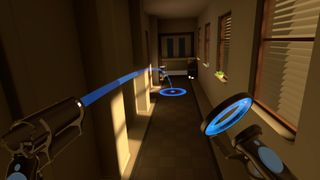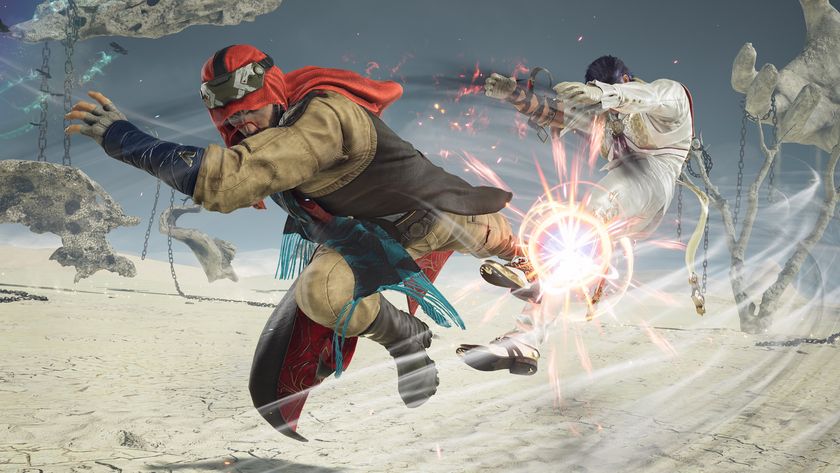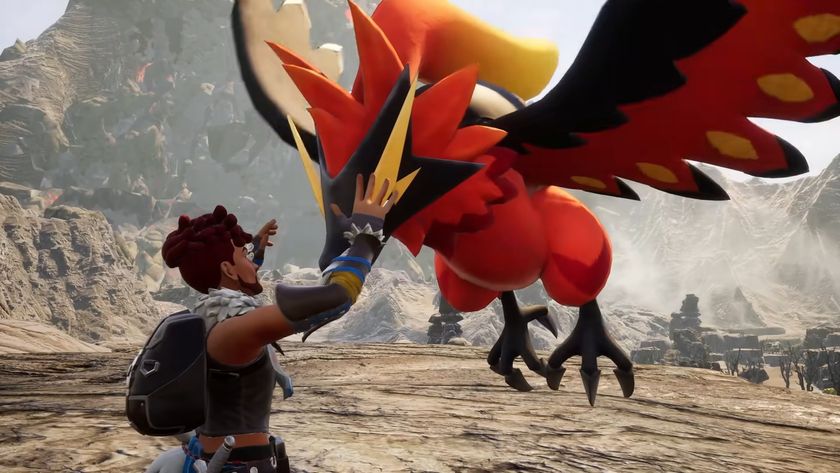What does (and doesn't) work in VR games
VR game development is a new frontier, and like with many things that are only starting to be explored, there’s still plenty to learn and understand. We got our fill of VR game demos at this year's Games Developers Conference and overall it was an exciting and enlightening experience. VR is capable of changing the entire landscape of gaming, giving players the chance to physically step into unbelievable virtual worlds. But everything isn't quite perfect yet. There are game elements and concepts that work exceptionally well, but there are also features that make VR an uncomfortable experience. Here's what works, what doesn't, and what will totally make you puke.

Works: stationary puzzle games
Solving a puzzle in VR is a totally different experience than playing on a traditional 2D screen. In games like Carpe Lucem - Seize the Light, you sit in a vibrant world surrounded by floating objects which you can manipulate in 3D space. You just sit there, move things around, and discover how everything fits together, sometimes having to rotate your head to either side to find puzzle pieces. You just sit stationary for each puzzle, so there is no nausea or movement to confuse your brain. It can be an oddly relaxing experience as you're literally surrounded by a puzzle getting completely absorbed in the task before you.

Works: any type of horror
VR is going to straight-up revolutionize how we play horror games, and what kind of blood-pressure-spiking scares the player can be put through (at the risk of any heart palpitations or a permanently scarred psyche). Because VR is such an engrossing sensory experience, purposefully designed to trick your brain into believing the unreal, the sensation of fear is made infinitely more intense; you're completely enclosed in a horrific scenario, without any distance between you and a screen. Horror VR could change game ratings forever, and until you experience it for yourself, you have no idea what it feels like to have a psycho killer or gruesome phantasm screaming directly in your face with the kind of abruptness and visual detail that's only possible in a virtual world.

Doesn't work: third-person adventures with rotating cameras
During a seminar about making the survival horror game Edge of Nowhere, Insomniac Games' Brian Allgeier talked about the challenge of designing VR games around the third-person perspective, which operates under different rules than the typical 'it's like you're really there' feeling of first-person VR. The trick is that you always want some kind of forward movement and a relatively fixed camera angle, because trying to crane your head and deviate from the behind-the-back perspective is a surefire way to trigger nausea and disorientation. Players need a visual reference point (such as the character they're controlling) to keep their focus in third-person, because constant camera rotation can only lead to queasiness.

Works: Sitting in a cockpit, rollercoaster, or on-rails vehicle
Gamers have piloted spaceships and aircraft or sat in rolling minecarts in plenty of games, but when you sit in a cockpit in VR, it's a totally different experience. You have the ability to look in every direction while separately controlling your craft making you feel like you're actually sitting in the pilot's seat. Another thing to consider is, moving around in a virtual world can be very disorienting and developers seem to find that putting players into cockpits and on-rails negates the nausea.

Works: using 1-to-1 motion controls
This is where VR gaming starts feeling like Star Trek's holodeck. Motion controls have come a long way since the Wii-remote. Devices like the HTC Vive and the PS Move motion controllers seem to pick up every bit of movement without latency. So, every time you swing your laser racket in a zero-gravity tennis game, swing a lightsaber, or nock an arrow to a bow and let it fly, it feels like you're actually doing those actions in real life.

Doesn't work: reading text
Perusing computer logs and scanning the email accounts of the recently deceased is a classic technique for world-building, used in plenty of games old and new. But such a simple activity like reading can become a figurative and literal headache in VR. It's typically a case of depth perception: either the text is too far away, causing your eyes to strain as they refocus, or it's all up in your face, forcing you to uncomfortably turn your head back and forth just to follow along. A sentence is fine, but a paragraph of exposition just doesn't fly in VR. And that's ok, because quite honestly, reading text is one of the most boring things you can do with VR, and feels like a total misuse of a technology that's specifically designed to show, not tell, its immersive experiences.
Sign up to the 12DOVE Newsletter
Weekly digests, tales from the communities you love, and more

Works: using your head as a cursor
We're hardwired to want to look at what we're doing in games, with visual information playing such a crucial role in level design, enemy encounters, collectibles, and so on. Besides, at a basic level, beholding all the cool stuff we're actively doing is an inherent part of what makes games fun. VR harnesses our natural instincts perfectly, with many of its games treating your straight-ahead gaze as a cursor or crosshair, which leads to natural head movements as you turn to fixate on the button you want to press, or the enemy you want to headshot. This control scheme isn't a standard across all VR experiences, but works wonderfully for any of the 'seated position' games we mentioned earlier.

Doesn't work: using a controller to walk or look around
This one doesn't sound like it would be a problem. I mean, how nauseating could it be to use a controller to walk around in a digital world? We do it all the time in other games, right? Movement is a bit different when it comes to VR. When you put on a VR headset, it actually feels like you're standing in that digital world, so your brain makes some assumptions. For some people, their brains assume it should be feeling the motion that it's seeing. When there's no feeling of acceleration and no physical body motion outside of moving a control stick, your brain gets confused and then the barfy feels come.

Works: Teleporting from place to place
With movement being such a huge challenge in VR, developers are finding ways to get players from one place in the virtual world to another. Walking, running, and jumping can make players nauseated, so teleportation seems to be the optimal solution. Some games are making the teleport as simple as blacking out the screen then having you appear in the new spot, and other games integrate teleportation mechanics into the gameplay - giving you teleportation guns that zap you to any location you can point to.

Doesn't work: high-speed movement
Think about how fast players look around using a game's standard controls. You can whip your head around incredibly fast performing 360 degree, mid-air spins with no problem. Now imagine being whipped around like that in real life. (Barf.) In VR, high-speed movement affects you similarly to doing it in real life - because your brain might think you're moving quickly when you're really aren't. Speed hurts in VR, so it's unlikely that we'll ever see intensely speedy series like Unreal Tournament (pictured above) make the jump.

Works: Semi-realistic firearms
If you've ever played Namco's classic arcade shooters like Time Crisis or Point Blank, you know that there's a certain satisfaction inherent to some kickback when firing plastic pistols. Now, regardless of how you feel about guns in the real world, firearms have and will continue to be a critical component in countless games. And something as simple as sudden feedback to pulling the virtual trigger - a precise, localized jolt rather than the broad strokes of a rumbling controller - can completely retextualize the act of shooting a gun in VR. You might feel detached from dual-wielding pistols in something like Call of Duty or Max Payne, but in VR, you actually feel some heft and force to your weapons, which is undeniably powerful in heightening your immersion.

Doesn't work: making the environment look too realistic
The trick to making a truly immersive VR game is to make the player's world easy for their brain to understand. Go the realistic route and you need to take everything that we normally perceive in the real world and perfectly replicate that in the virtual world. So, if you sit on a couch in VR the developers have to ask themselves if the perspective is correct and even if the cushions getting smushed under your weight make the right sound at the right time. If players feel like they are too short or tall, the movement is too fast, or the sound design is just a little bit off, they can get disoriented and ultimately have a disappointing experience.
Many years ago, Lorenzo Veloria was a Senior Editor here at 12DOVE helping to shape content strategy. Since then, Lorenzo has shifted his attention to Future Plc's broader video game portfolio, working as a Senior Brand Marketing Manager to oversee the development of advertising pitches and marketing strategies for the department. He might not have all that much time to write about games anymore, but he's still focused on making sure the latest and greatest end up in front of your eyes one way or another.

Palworld dev "secretly" brought a game it's publishing to an event that's "not like anything we've been involved in" and reactions are "very positive"

After preserving the AI ghost of a fan's late brother, Tekken 8 boss says it might be a glimpse of the future where you don't "need an opponent who is human that has the exact same skill level"











